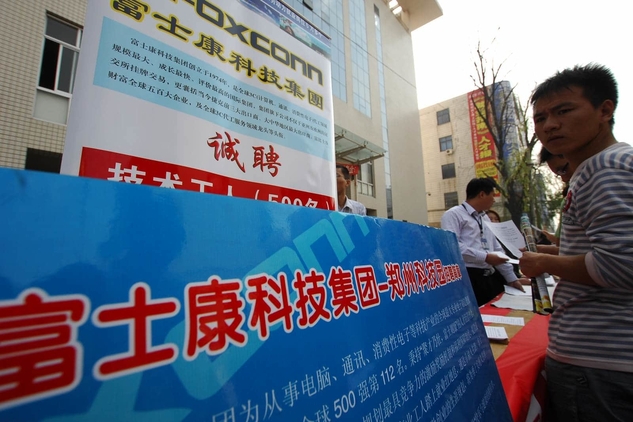Apple Supply Chain Disrupted by Novel Coronavirus, Expediting the Flight of Foreign Investment from China

Source:Kuo-Tai Liu
“The US-China trade war has fired the first shot; the coronavirus fired the second.” The novel coronavirus is testing the adaptability of Taiwanese electronics manufacturers with production facilities in China. This is no longer a short-term question of when the assembly lines can get back to work, but rather a mid- to long-term one of how production capacities should be reorganized in the region.
Views
Apple Supply Chain Disrupted by Novel Coronavirus, Expediting the Flight of Foreign Investment from China
By Elaine HuangFrom CommonWealth Magazine (vol. 691 )
The world’s largest smartphone factory lies in Zhengzhou, Henan Province, where Foxconn produces 50% of Apple’s iPhones.
On the evening of February 4th, Zhengzhou announced a state of “closed environment control” as a result of the novel coronavirus outbreak. The city of ten million had to make sure that every institution, company and community block within its borders keep only one entrance open. Every person passing through must be identified and have their body temperatures checked. The electronics industry and its analysts went into a frenzy.
“(Apple CEO) Mr. Cook was probably roused out of bed, it’s two in the morning on the west coast now,” one analyst jokes.
Nobody could have foreseen the crisis falling on the weekend before everyone went back to work after the Lunar New Year holidays. Apple supply chain clusters in the Yangtze River Delta Economic Zone, such as Nanjing, Kunshan, even Shenzhen, the major component manufacturer of the Pearl River Delta, went into semi-lockdown mode. Apple’s manufacturing facilities in China, which were scheduled to reopen on February 10th, are facing the dual crises of manpower shortage and a halt in production.
Foxconn: Work Cannot Resume Without Approval from Local Authorities
Without singling out any one client or plant location in particular, Foxconn made a statement on the 8th that individual factories will only resume work in accordance with rules and regulations set down by local governments.
Sources said, for work to actually resume on the 10th, official approval is required. “In compliance with laws and regulations, authorization to reopen the plants is needed before we get back to work,” was the official reply Foxconn gave CommonWealth Magazine.
The most direct impact will be on Apple’s all-new budget iPhone SE2, scheduled to launch in March. Can the supply chain keep up with demand? The world wonders.
Challenge One: How Serious is the Staffing Shortage? How Much Time Until Everyone Returns to Work?
In truth, for the past few years, large contract manufacturers such as Foxconn and Pegatron are used to seeing manpower shortage right after the Lunar New Year holidays.
“It’s normal to experience 20% to 30% staffing shortage after the holidays, but this year we might see 20% more.” According to a member of senior management in an Apple assembly plant, staffing shortage may be as high as 50% when work resumes.
Foxconn has come prepared. According to the senior manager, in anticipation of trouble in Zhengzhou, Foxconn has already repurposed parts of the iPad assembly lines to produce iPhones. If all goes according to plan, production will only be delayed by about a week; if not, the production of around five hundred thousand iPhones a day risk being delayed by as much as an entire month.
The million-dollar question is, how many workers could return to the assembly lines upon reopening? And how fast could they return?
Workers from Hubei make up about 10% of Foxconn’s assembly line. In Zhengzhou and Chengdu, where most of Apple’s iPhones and iPads are made, the factory workers are mostly from Henan and Sichuan. Workers there would have an easier time returning. In contrast, 90% of workers in Shenzhen’s Longhua plant are from out of town. Therein lies the main challenge.
“It is impossible that production capacity will be at 100% on reopening day. The Chinese government won’t allow it. More likely, production will be ramped up gradually,” observes a Taiwanese staff member of the Apple supply chain. With the epidemic worsening, disease prevention is more important than economic loss.
Challenge Two: How Much Material is Left in Stock?
A senior technology analyst who experienced the SARS outbreak in 2003 is worried that if work is not resumed successfully by late February or early March, staffing shortage will likely lead to a shortage of raw materials. The electronics industry may be at risk of supply chain disruption.
A senior Taiwanese manager in the laptop business says companies have started taking stock of their inventories when the Wuhan coronavirus showed no sign of slowing down over the Lunar New Year.
Right now, they have enough stock until the end of February. But whether OEMs and ODMs will have enough raw material after that, is still unknown.
He says, “It may become a fight over raw materials as various companies scramble to secure their sources of raw materials.”
A Warning Against Over-reliance on China
From a perspective of risk diversification, manufacturers for the Apple supply chain should consider not only the short-term issue of whether they could reopen productions, but rather the mid- to long-term question of how to reorganize their production capacities in the region.
“This poses a grave danger to China’s future,” says a senior manager at a chassis plant in Jiangsu. The virus outbreak was a wake-up call for electronics companies still debating whether they should move out of China. “For the last two decades, they (foreign brands) had it too easy. When China offered cheap land and labor, they forgot to diversify their risks.”
Apple has stipulated that from now on, all suppliers must have production capacities in at least two plants in two countries. Suppliers have interpreted this as saying that they must also have production facilities in Southeast Asia or other locations other than China if they want to work with Apple.
A new race has begun.
One battlefield is AirPods, Apple’s best-selling wireless earphones. A Taiwanese general manager of an Apple supplier reveals that, “70% of this year’s orders were gobbled up by (Chinese company) Luxshare Precision.”
Luxshare has the reputation of being the “little Foxconn” of Southern China. In just two years, they built three factories and hired fifty thousand workers in Bắc Giang, Vietnam. Their scale exceeds Foxconn in northern Vietnam.
A general manager at a major laptop component manufacturer summarizes that the US-China trade war pushed companies selling to the US market out of China; after the novel coronavirus outbreak, only companies catering to the Chinese market will stay in China.
This means in the next few years, trillions in production value and tens of millions of jobs will be pouring out of China like a flood.
Take for example China’s annual production of two hundred million iPhones, only 15% are sold to the local market. In an extreme scenaio, the production of over a hundred million iPhones might be relocated outside of China.
“It is nearly impossible because staffing requirements and production difficulty for the iPhone assembly lines are very high,” confesses a senior manager. “But we all have an understanding that the diversification of production capacities is inevitable.”
Laptop Factories Up the Ante in Northern Vietnam
Photo by Ming-Tang Huang/CW
Laptop companies moving production to Vietnam is already a trend. Following the US-China trade war in 2019, Compal and Wistron increased investment or opened new plants in northern Vietnam, even though Wistron already had production lines in the Philippines.
At the end of 2019, Wistron decided to invest in Hà Nam Province in northern Vietnam. Construction of the new plant is scheduled to begin this May, with production in the pipeline by mid-2021.
“The trade war has fired the first shot; the coronavirus fired the second. Everyone agrees that moving out of China is the right decision,” says a member of senior management at Wistron.
Wistron and Compal—that’s the world’s largest and third largest laptop manufacturers taking root in northern Vietnam.
“Ever since the trade war began, every time Trump says something, more and more companies come to northern Vietnam to buy land and build factories. Property prices are shooting up,” says Hong Chi-Hwa, Chairman of the Council of Taiwanese Chambers of Commerce in Hanoi (河內商會會長洪志華).
In the hottest industrial zones in Bac Ninh Province, property prices went from US$60 per square meter in early 2019 to as high as US$80.
The Mid- to Long-term Strategy is the Crux
Not everyone is flocking to northern Vietnam. Quanta Computer, a major MacBook manufacturer, not only moved production lines back to Taiwan, but also set up a subsidiary company in Thailand.
“Thailand already had component manufacturers such as Cal-Comp (泰金寶) and Delta Electronics Thailand (泰達電). It is another important electronics industry cluster besides northern Vietnam,” observes a general manager in the OEM and ODM business.
Estimating from an OEM and ODM perspective, he forecasts that around 10% of production will move out of China in the next three years. This number may move up to 20% in the next five years.
“The virus will not defeat us, and we must not defeat ourselves.” He stresses the importance of mid- to long-term planning.
No one knows where the epidemic will take us. But for suppliers that have been through all sorts of crises, the trouble reopening their assembly lines is only short-term. Looking to the future, to always keep abreast of the times is the real crux of the matter.
Have you read?
♦ Desperation in Wuhan
♦ University of Hong Kong: Epidemic to Spread Until May
♦ Coronavirus Outbreak is a Disaster of China's Nationalism: Academia Sinica Scholar
Translated by Jack C.












